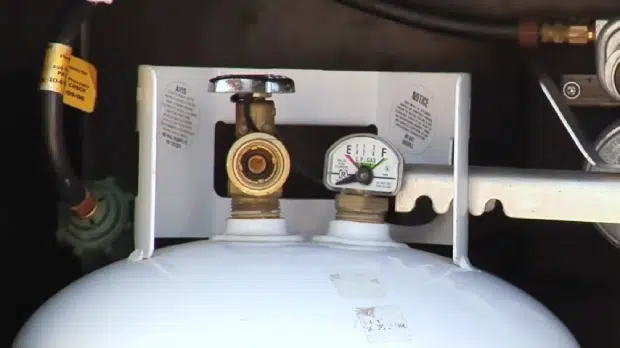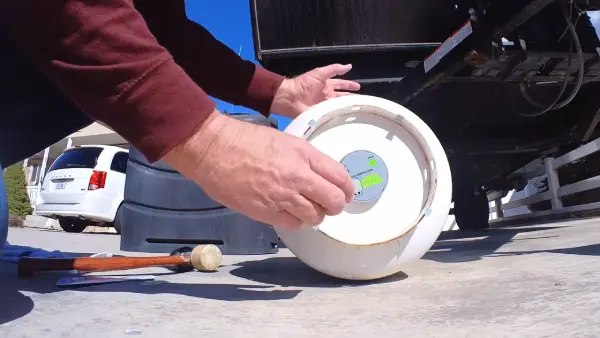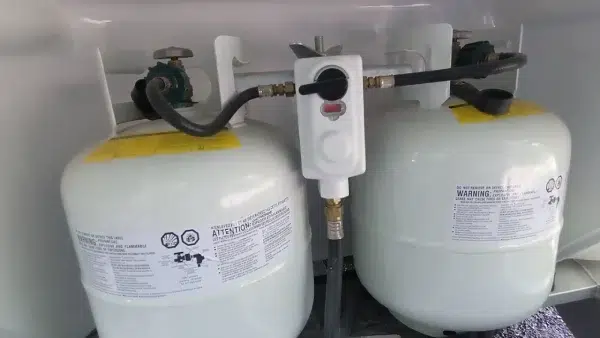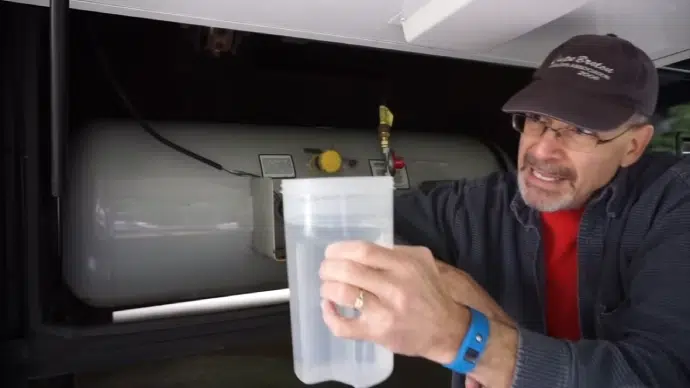Last Updated on May 22, 2023
Knowing what you’re up to with your propane tank is crucial for planning a camping trip with your RV or simply using it as a mobile vacation home. It would be terrible to run out of propane midway through cooking dinner or taking a hot shower.
Checking the propane tank level isn’t rocket science and can be done easily, even if you’re not an expert on all things RV-related. You can use either gauge or weigh it to check the propane level.
When using a gauge, turn off all appliances before checking the level. Then, locate the gauge on your tank and read the gauge reading.
If you are going to weigh your tank, please turn off all appliances and disconnect the water supply line before you do so. Then, calculate the remaining gas level based on the tank’s weight.
Here, we’ll explain step-by-step how to check your RV propane tank level so you can stay ahead of the game and enjoy all your outdoor adventures without any unexpected surprises.
How to Check Your RV Propane Tank Level: 2 Ways

Propane is a commonly used fuel source for RVs, powering appliances such as stoves, refrigerators, and water heaters. To check the propane level of your RV tank, you can use two main methods.
Method 1: Using a Gauge
Maximum propane tanks for RVs are not equipped with a gauge. Luckily, you can purchase an aftermarket gauge and install it on the tank to measure the propane level. Here are the steps to follow when using a gauge:
Step 1: Turn Off All Appliances and Open Valve
Before attempting to check the propane level in your tank, you should always turn off all appliances and open the valve to release any pressure that may have built up inside the tank.
By turning off all appliances, you are ensuring there is no risk of a gas leak or fire while checking the propane level. Opening the valve will allow any excess pressure to escape, making reading the gauge or weighing the tank easier and safer.
Step 2: Locate the Gauge on the Tank
The gauge is usually located on the top of the tank and can be easily accessed. Then unscrew the plastic cap that covers it. Check to ensure that the dial is pointing straight up.
Step 3: Read the Gauge Reading
Once you have located the gauge, look for a needle or digital reading that indicates how much propane is left in your tank. If your gauge displays a percentage, it will typically range from 5% to 95%. If it displays gallons, it will show how many gallons of propane are left in your tank.
It is important to note that not all gauges are created equal and some may be more accurate than others. Therefore, double-checking your gauge reading with another method, such as weighing your tank, is always a good idea.
Method 2: Weighing the Tank
Weighing the propane tank is another way to check the level of propane in your RV. This method involves disconnecting the service line and weighing the entire tank to determine how much propane is left. Here are the steps:
Step 1: Turn Off All Appliances and Disconnect Service Line
Before weighing the propane tank, turn off all propane appliances and disconnect the service line. This ensures no pressure in the lines and makes it easier to weigh the tank accurately.
Step 2: Weigh the Propane Tank
To weigh your propane tank, you will need a scale capable of measuring weights up to at least 40 pounds. Place the empty scale on a flat surface, then carefully lift your propane tank onto it. Make sure that the scale is stable and level before recording the weight.
Step 3: Calculate the Remaining Gas Level
Once you have weighed your propane tank, you can calculate how much gas is left by subtracting its tare weight (the weight of an empty tank) from its current weight. The tare weight is usually found on a sticker or plate affixed to the tank.
For example, if your propane tank weighs 60 pounds and its tear weight is 20 pounds, you have 40 pounds of gas left in your tank. Remember that most tanks are designed to hold only about 80% of their total capacity for safety reasons, so you should refill or replace your tank before it gets too low.
Factors That Affect RV Propane Consumption

Several factors can affect the consumption of propane in your RV. Understanding these factors can help you plan and manage your propane usage more efficiently, ensuring you have enough propane for all your needs. Here are some of the main factors to consider:
Temperature Changes
Your RV’s propane consumption can be affected significantly by changes in temperature. Propane is stored as a liquid under pressure and converted to gas when released from the tank. The rate at which this conversion occurs depends on the temperature of the propane.
In cold temperatures, propane will convert to gas slowly, so appliances may not function properly or consume more propane than usual. On the other hand, in hot temperatures, propane will convert to gas more quickly, which can result in higher consumption rates.
It’s important to monitor the temperature outside and adjust your propane usage accordingly. For example, if it’s very cold outside, you may need to increase your propane usage to compensate for slower conversion rates.
Conversely, if it’s very hot outside, you may need to decrease your usage to avoid consuming too much propane.
In addition to outdoor temperatures, it’s also important to consider the temperature of your appliances. Some appliances are designed to operate more efficiently at certain temperatures. For example, a furnace may be more efficient when it’s colder outside because it doesn’t have to work as hard to heat up the RV.
Appliance Usage and Efficiency
The usage and efficiency of your RV propane appliances can significantly impact the amount of propane consumed. Understanding how to use these appliances correctly, maintain them regularly, and ensure they are working efficiently is essential.
Cleaning or replacing the burner elements is one way to improve appliance efficiency. Dirty or damaged burners can cause the propane to burn inefficiently, leading to higher consumption rates. Also, regular maintenance of appliances such as refrigerators and water heaters can help ensure they run efficiently.
Another factor that affects propane usage is how often you use the appliances. The more frequently you use them, the more propane they will consume. It’s important to be mindful of your usage habits and try to limit unnecessary use when possible.
Also, consider upgrading your RV appliances to more energy-efficient models. Newer models are designed with better insulation and technology that allows for more efficient use of propane.
Age of the Propane Tank
The age of your RV propane tank can significantly impact its performance and lifespan. Over time, propane tanks can become corroded or damaged, leading to leaks or other safety hazards. It is important to inspect and replace your propane tank, if necessary, regularly.
Most propane tanks have a lifespan of around 10 years, after which they should be replaced. But, this can vary depending on the manufacturer and how well the tank has been maintained. If you are still determining the age or condition of your propane tank, it is best to have it inspected by a professional.
How can I check the propane tank pressure to determine the propane level?

It is important to check your tank pressure and propane level to ensure that you never run out of propane while using your system. The process of checking the propane tank pressure is very simple and straightforward. You only need a propane tank pressure gauge, which can easily be purchased at any hardware store.
Once you have acquired a propane tank pressure gauge, you can attach it to the propane tank valve and open it briefly. The gauge will show the pressure level, which can be used to determine the propane level.
It is important to note that the propane tank pressure gauge reading should be taken at room temperature. As temperatures increase, so does the pressure inside the tank, which can result in an inaccurate reading. Therefore, it is advisable to wait until the tank and gauge have reached room temperature before taking a reading.
How often should I check my RV propane tank level?
Check the level before each trip and periodically during your trip to avoid running out of propane while using your RV propane tank. The frequency of checks also depends on the size of your propane tank and how often you use it.
For instance, smaller propane tanks, such as the 20 lb propane tank, may require more frequent checks as they tend to run out faster than larger propane tanks. Generally speaking, checking your propane tank level every two to three days should be sufficient.
Therefore, it is important to monitor the propane usage in your RV and adjust your checking frequency accordingly.
Can I use an LP monitor on RV 30 lb aluminum tanks?
You can use an LP (propane) monitor on RV 30 lb aluminum propane tanks. Most LP monitors are designed to work with a standard OPD (overfill prevention device) valve, which is found on most propane tanks, including 30 lb aluminum tanks.
But, it is important to check the specifications of the LP monitor to ensure that it is compatible with your specific propane tank before making any purchases. Following the manufacturer’s instructions for installing and using the LP monitor is also important. This will ensure that the monitor operates properly and safely.
Proactive Monitoring of Your RV Propane Tank Can Ensure Your Safety
Understanding your RV propane tank and checking its level regularly is crucial for a safe and enjoyable trip. You can check your propane tank level using two methods: using a gauge or weighing the tank. Both methods are easy to follow, but you must take safety precautions before attempting any of them.
Factors that affect RV propane consumption include temperature changes, appliance usage and efficiency, and the age of the propane tank. These factors can help you manage your propane supply better while on the road.
Remember that propane is a highly flammable gas that requires careful handling. Always turn off all appliances and disconnect service lines before attempting to check your propane tank level. And if you need more confidence about doing it yourself, seek professional help.


